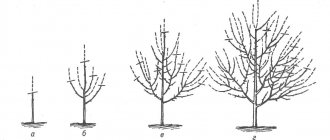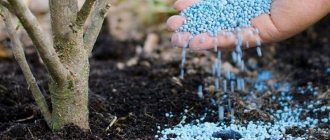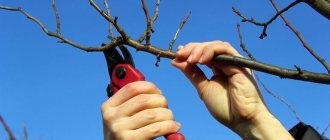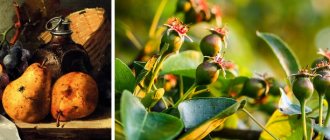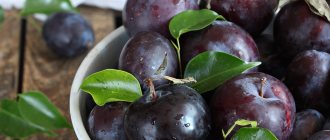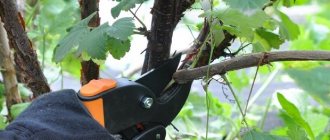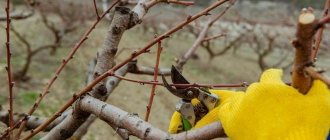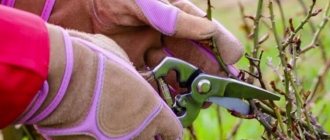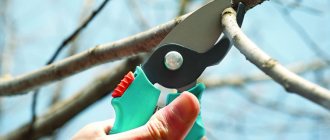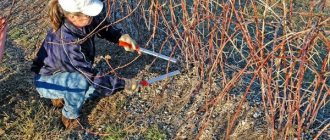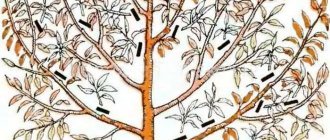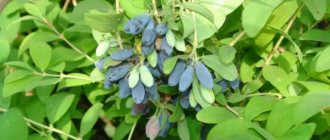What kind of pruning is there?
For fruit trees, several pruning techniques are used depending on the time of year, the age of the tree and the intended purpose.
Types of pruning:
- Formative - is crucial in the first 5–6 years, when the crown of the fruit tree is actively forming; is held in the spring.
- Thinning is a permanent operation applied to pears of any age; The tops that thicken the shoots are removed.
- Sanitary – performed in the fall; remove incorrectly growing (inside the crown, rubbing), dry and diseased branches.
- Rejuvenating - it is needed by old trees, whose upper half of the “body”, as a rule, dries out; pruning is carried out to healthy wood.
When is the best time to prune a pear tree?
Pruning is carried out in the spring at temperatures from 0 °C to a stable +5 °C, but before sap flow begins, when the buds begin to grow. The deadlines for regions are always individual, but, in general, this time occurs in March-April.
In the summer, starting in June, pinching is carried out - pinching off the tops of young shoots. For what? The forces for the growth of shoots in length are directed to the formation of fruits, the ripening of fruits is accelerated.
From late August to mid-September, when sap flow slows down, autumn pruning is carried out. Before frost, live wood on cuts and cuts will dry thoroughly and the risk of freezing will be minimal.
Trimming rules:
- use a sharp instrument and periodically disinfect it;
- the branches are cut into a ring, without leaving stumps, which heal slowly, and are also overgrown with a brush of tops (what does it mean to cut into a ring? At the base of each branch there is a cambial ring - a thickening or swelling at the point where the branch joins the trunk, the cut is made parallel to the line of the ring with outside);
- thick branches are cut down in different ways: in the first pass, half of the branch is cut off, then the cut follows the intended line;
- the first cut is made from below, the second and final from above (this way the cut fragment will not pull the bark along with it, the cut is smooth and quickly tightens);
The cut passes along the outer edge of the cambial ring
How pear trees react to pruning
Sometimes a pear tree does not react to pruning the way you would like it to, and grows “in the wrong steppe.” Such disobedience depends on the variety and its inherent type of growth. Therefore, sometimes light pruning is combined with other techniques, for example, bending.
There are varieties with apical (apical) dominance of shoots, and others with lateral dominance. Some with good shoot formation, some with bad ones. There are varieties with a right angle of shoot departure, and others with an acute angle (mesotonic and basiconic). Varieties with a mesotonic type of branching with a wide angle of branching of branches are perfectly formed: Pamyati Yakovlev, Avgustovskaya rosa, Lastochka. It is a pleasure to form such varieties - we cut the young seedling to a standard height of + 20 cm and remove unnecessary side shoots in the summer - the tree forms itself. The forming scheme for such pears is sparsely tiered. And a variety like Bryanskaya Krasavitsa has apical dominance. Those. all the growth force goes into one single shoot, which simply clogs the rest. It is impossible to form such a tree by pruning! When pruning, you get one or two shoots, but with such sharp angles that they literally run parallel to the trunk. Such varieties are formed with horizontal cordons. This is when one shoot is kicked out and then bent. The shoots that grow from the bending places are thinned out and again bent in the opposite direction, etc.
Yri
https://dacha.wcb.ru/lofiversion/index.php?t29694–400.html
Bending
There is no way to bypass this technique - bending down or pulling branches up (for drooping crowns) to give them a horizontal position. It is on such branches that most flower buds are formed. Skeletal branches do not bend. Bending back non-lignified shoots in spring and summer is more productive, safer, easier and takes less time. When bent in the spring, the branches will quickly take a new shape, but if this is done in the fall, there will be zero benefit - you cannot convince a sleeping branch that it needs to be fixed in a new position. Lignified branches are also bent, but this is much more difficult to do; physical strength and extreme caution are required so as not to break anything off. The process takes place gradually, step by step, so it will not be possible to complete it in one season.
Sharp branch angles are a constant risk area
If a branch leaves the trunk at the desired (not acute) angle and then sharply rushes into the sky, it is deflected to a more horizontal position. A loop of twine is attached at a distance of 2/3 of the length of the branch from the trunk, the other end is fixed to a stake driven into the ground or to the trunk, or a spacer is placed between the branch and the trunk. Branches that are too inclined are pulled upward, making it difficult to weed and loosen the soil. They are fixed to the trunk or to a pole, which is tied to the trunk. A ring is attached to the upper end of the pole through which one or more garters are passed. To prevent the string from cutting into the bark, a lining is placed under it on the branch. Otherwise, the cord or twine will cut into the bark, disrupting the movement of nutrients, the branch dries out, becomes brittle and dies.
You can bend a pear branch in a variety of ways.
Bending is great for shaping the crown of a dwarf pear. Branches 15 cm long are bent horizontally, shoots are cut out at an acute angle, and the stem is shortened so that it is 40 cm higher than the upper branch. Next season, the resulting horizontal shoots 30 cm long are left for ovaries, and stronger and longer ones (40–50 cm) cut into several buds. The stronger dominant branches are cut into a ring, the central conductor is again shortened to the same height as before.
Pincing
It is carried out in June using pruning shears or your fingers. The top of the young growth with 4–5 leaves is pinched. After 10 days, the procedure is repeated, i.e., tweezing will take place three times in a month. Pinching slows down the growth of the crown in length and nutrients flow to the fruits.
Features of the procedure
Some pear varieties are characterized by rather slow growth, but the crown still needs professional shaping. This procedure should be regular, regardless of the age of the tree. Beginners need to remember that the pruning technique is influenced by several main factors:
- age of the tree;
- intensity of crown overgrowth;
- julienne;
- type of trimming.
If the tree is not treated in a timely manner, the overgrown shoots will gradually deplete the plant’s immunity, which will lead to a decrease in yield. Autumn pruning of pears according to the scheme begins at the end of summer and continues until mid-September. You should not get carried away with cutting branches, as everything should be in moderation. If a novice gardener prunes too many shoots, the tree may not be able to cope with severe frosts.
Interesting! The peculiarity of the pear is that even with the arrival of winter, the juice does not stop circulating through the trunk, but the process occurs much more slowly, which impairs the possibility of micronutrients spreading throughout the tree. And during pruning of shoots, the sap moves faster, thereby facilitating the rapid healing of damaged areas.
The gardener should not miss pruning deadlines, since the tree must have time to adapt to changes and upcoming frosts. Opinions about pruning methods among experts today differ. Some believe that the amount of harvest increases significantly if excess shoots were cut off in the spring, since there is no risk of sudden cold snap or frost. Others, on the contrary, prefer winter pruning, believing that the pear is at rest and nothing will harm it.
But, as practice shows, in cold weather it is strictly forbidden to carry out drastic manipulations with a delicate pear. But the autumn formation of the crown allows you to prepare the pear for the upcoming cold weather and prevents it from dying.
The secret to pruning pears with different crown shapes
In general, the pruning technology is the same for a tree with any crown shape, but there is a small nuance. In pyramidal pears, the crown is “unfolded” - the shoots are cut to the outer bud, i.e., located on the outside. New shoots grow more deviated, more flower buds are laid on them, the crown becomes more luxuriant, and is better illuminated. You can replace pruning of branches growing upward by bending them down.
Formation of a crown-shaped crown
The crown of pears with drooping shoots is raised: a cut on the branch passes over the inner bud. Subsequently, the growth is directed inward to the crown and, as it were, lifts it. This technique in no way impairs fruiting, but makes the crown more compact and makes it easier to cultivate the soil in the tree trunk circles.
Forming a pear into a bowl
The crown is given the appropriate shape by cutting down the central conductor on purpose or when it is frozen, sick or shriveled. Skeletal branches of the first order surround the resulting void and the overall picture resembles a bowl. The advantage of this form is that the branches both outside and inside receive enough sunlight and are well ventilated.
Formation of the crown-bowl
Why do you need to prune a pear tree?
The tree loves sunlight very much. The main role of pear pruning is to thin out the crown and give it a certain shape. Carrying out the procedure regularly will not allow the plant to waste extra energy on growing young shoots. Pruning allows you to grow not only more fruits, but also improve their quality. This is ensured by the fact that the pear tree spends its energy and nutrients on fruit. Benefits of the procedure:
- increasing productivity;
- improvement of crown condition;
- removal of weak branches.
pear tree
Forming a pear will not allow the shoots to grow high up. Thanks to timely and correct pruning, the branches will not interfere with other crops growing on the site. Also, how convenient it will be to harvest the crop depends on this procedure.
Pruning a young pear in spring
The purpose of pruning a young tree is to gradually form a ventilated and well-lit crown that can withstand the load of fruit.
What is a "one year old"
This affectionate word is often used to describe annual seedlings. By the way, novice gardeners may have difficulty determining the age of a seedling. The answer is simple: a seedling that has survived the season is considered annual. That is, a pear planted in the fall of last year or this spring is considered annual.
Before purchasing a pear seedling of your favorite variety, the first thing to do is assess the condition of the root system - it should be fibrous, with intact tips, and moist. If the plant is sold with a closed root system (in a bag), lightly pick at the bark with your fingernail. The bottom layer of green color indicates that the seedling is alive and healthy; if it is brown, it is dry, and it will be of no use.
The yearling usually has a length of 80–100 cm and looks like a twig, as a rule, without side shoots or there will be one or two, but very short. Therefore, pruning at the first stage is the most unpretentious and will not raise questions even for a “teapot”.
Recent Entries
5 working ways to use tar in the garden 7 indoor plants that help you get married even in adulthood Indoor plants that can bloom in trouble
Trimming an annual pear
The seedling is planted according to all the rules in a permanent place, fixed to a peg and immediately after that pruned with pruning shears. Pears grafted onto a vigorous seed rootstock are pruned at a height of 70 cm from the ground directly above the bud. And seedlings obtained by grafting on a vegetatively propagated rootstock (dwarf) are shortened to a height of up to 50 cm. (Such nuances should be clarified with the seller). If you had to plant a pear with damaged roots, cut it a little more, about 10 cm, giving it the strength to restore its roots.
Metamorphoses of a seedling during the first year
The shortened stem (or central conductor) will still grow upward, it will release a shoot from the upper bud under the cut, and several side shoots will also appear. At first they will be grassy - green, tender and thin, and only over time they will turn into powerful skeletal branches. The skeleton, in turn, will be overgrown with semi-skeletal branches with leaves, buds and flowers. After some time, growth will appear below the grafting site, which should be removed. It will absorb some of the nutrients and create shade, but will not produce high-quality fruits.
Learning to trim a branch correctly
Pruning pear seedlings in the second year
Two-year-old seedlings usually grow 6–8 lateral shoots, from which skeletal branches form. To do this, leave 3-4 branches (the rest are cut into a ring), evenly spaced around the circumference and spaced from each other in height by about 15-20 cm. For a person who has taken up gardening for the first time, for clarity, you can imagine an umbrella, where the rod is the trunk, and the spokes are the side shoots. Only in our case, these knitting needles, that is, the shoots, are not located at the same level, but each one is slightly higher than the other. The angle of deviation of the skeletal branches from the trunk should not be too sharp - 45-50°. Anywhere in the tree, such sharp joints are easily split in strong winds, leaving deep wounds that are difficult to heal.
An acute angle is the most unreliable for wood; it splits easily
Cut the skeletal branches by ¼ to the outer bud, but in such a way that each of them is slightly lower than the previous one. Thus, the principle of subordination is fulfilled - lower growing branches should not rise above higher growing ones. Lateral branches at the ends of the skeletal branches, reminiscent of bird's feet, make the continuation shoot shorter. The central conductor (trunk) is cut so that it rises 25 cm above the rest. If a competing shoot has grown near the central conductor (and it will definitely grow at an acute angle), it is cut into a ring. If the pear is rapidly stretching upward, cut the central conductor to the first weak side shoot, and so that it grows vertically, it is pulled to the peg with twine.
Pruning a two-year-old pear
Competitors also grow on skeletal branches (the end of the shoot resembles a bunch), they are also cut into a ring. After pruning, nitrogen fertilizing is avoided so that the tree devotes all its energy to healing the cuts and not to growing green mass. It happens that one branch grows above another. In the future, the upper one will obscure the lower one, they will get confused, so one of them is removed.
Pruning a three-year-old pear
In the first sitting, the central conductor is cut to ¼ of the height, about 25 cm is left from the new growth, the rest is cut to the inner bud (so that the crown is not spreading). The next season, competitors of the central conductor and on the skeletal branches are amputated. Powerful tops are cut into rings, and thin ones are bent and shortened by a quarter, turning them into semi-skeletal productive branches. All branches with an acute angle of departure, as well as those that violate the harmonious structure of the crown, are removed. If the trunk is low and the lower skeletal branches lean towards the ground, they are shortened. In general, pruning a three-year-old tree is similar to working with a two-year-old seedling.
Pruning a three-year-old and two-year-old pear is very similar
Pruning a four-year-old pear
At this age, the second tier is laid, observing the already known rules:
- avoid sharp angles where branches depart from the trunk;
- removal of competitors;
- subordination - the upper tier should not overlap the lower one, the central conductor is longer than the branches.
Annual growth on four-year-old pears is not shortened, so as not to activate growth processes. Branches that stand out from the general pattern are pruned into an annual ring or fruit-bearing wood; tops are eliminated.
Pruning a four-year-old pear also comes down mainly to thinning and eliminating competing shoots
Dates
In the spring, pears are pruned before the process of sap flow begins, a sign of which is the blossoming buds. At the same time, some gardeners recommend planning work for the period when the weather is still frosty, while others recommend planning work when the air temperature is already positive.
Expert opinion
Stanislav Pavlovich
Gardener with 17 years of experience and our expert
Ask a Question
Important! Do not prune at air temperatures below -10C.
The exact timing depends on the climatic characteristics of the region and the prevailing weather, but in any case, the work must be completed before the sap begins to flow.
It is not recommended to prune trees in the fall, since this procedure weakens them and reduces winter hardiness. During this period, active plant protection is suspended, so pathogenic microorganisms have every chance of penetrating into fresh wounds on the pear. With the onset of cold weather, the cambium freezes, which makes it difficult for wounds to heal.
Summer pruning is also called shelling and involves pinching out improperly growing shoots. Green twigs are easily shelled with a fingernail. If you carry out this procedure in July, then in the fall there will be much less work on caring for the pear. In addition, the tree directs all its energy not to growing extra branches, but to ripening the crop.
In exceptional cases, sanitary pruning of pear trees is carried out in the summer. It may be required if the plant was damaged due to gusts of strong wind, hail or other adverse weather conditions, or was also affected by pests or diseases.
Mature trees
By the age of five, the crown of a pear is considered formed and does not require special intervention for several years. A tree aged 6 to 8 years looks like a self-sufficient bourgeois with a leisurely life schedule. The shortening of branches is kept to a minimum because their annual growth is noticeably reduced. Pruning is mainly aimed at maintaining a good sanitary condition of the tree.
Over time, the crown of adult pears gradually thickens and the overgrown branches will not receive enough sunlight. In this case, thinning is carried out, which is extended over 2–3 years. Why so long? To maintain a balance between the crown and its “reflection” - the roots. The thinning procedure begins in the spring. In one sitting, two to three-year-old thick branches, the diameter of which is half the diameter of the central conductor, are cut down inside the crown into a replacement knot. No more than two such branches are removed at a time.
Branch replacement pruning helps replace old branches with new ones.
The branch is shortened to a fruiting branch, and the shoot located below is cut into two buds - this will be a replacement knot. By the way, when they say “cut to two or five, etc. buds,” this means that this number of buds remains on the shortened shoot. The next year, shoots grow from the remaining buds on the replacement branch. They will perform the functions of the previous branch, therefore they are also called replacement branches. The trunk or central conductor is shortened to 3–3.5 m. Places near the cuts are overgrown with a brush of young shoots (future tops) from awakened buds, they are broken out at the end of May.
It’s good to teach others when the pear tree under the window is begging (now I just feel it) to be “combed.” The tree is 10 years old, in appearance it resembles a cypress, its height is 3 m. It bears fruit in a year, the minimum weight of the fruit is 250 g, no one remembers the name of the variety. So, on this specimen, it is necessary to remove the competitors of the central conductor, subordinate the skeletal branches and cut them to the outer bud. Having worked some magic in Paint, I came up with a very nice version of the updated pear.
Removing many competitors and pruning side branches should encourage lateral branching
Video: pruning an adult pear
Pruning an old pear
A tree 15 years old and older is considered an aksakal and requires radical rejuvenation. The signal for this is a reduction in growth to 15–20 cm. Anti-aging pruning of pears is carried out gradually over two to three seasons, and work begins in the spring before the buds open. Rejuvenation is best done after a lean year, when an abundance of flower buds have formed on the tree.
After rejuvenating pruning, bald branches become overgrown with twigs
If there are several thick dry branches, several of them are cut down every year, and the wounds are covered with garden varnish. Then the cuts are wrapped in dark film until September, so the cuts will heal 2-3 times faster. The annual growth is shortened by ¼ of its total length. “Irregular” branches—those growing inward, vertically, and crossing—are also pruned.
Caring for the pear after the procedure
Immediately after pruning, all wounds are treated with garden varnish to prevent harmful bacteria and moisture from entering there, causing decay. It is important to ensure that the soil in the tree trunk does not dry out. To do this, organize systematic regular watering.
After pruning, the pear should have enough nutrients to grow green mass, begin to bear fruit and heal wounds. For this purpose, organic and mineral fertilizers are applied to the tree trunk circle, and then the soil is mulched. If basal growth appears, it is immediately removed so that unnecessary shoots do not take away the juices and vitality from the pear.
Pruning frozen trees
Depending on the degree of frost damage, appropriate pruning is carried out. If the top of an annual pear planted in the fall is frozen, it is cut off by 1/3 of its length. However, this operation is indicated for all one-year-old seedlings, so frost does not seem to cause much harm.
In older trees with a developed branch system, pruning is more severe. First, the branches are inspected, identifying lesions - the wood in these places is brown or black. If the branch is mostly or completely frozen, it is cut into a ring. The affected upper parts are cut back to healthy wood.
Step-by-step pruning of thick branches is convenient for humans and does not injure the tree
When performing such pruning, they think first of all about the health of the tree; the beauty of the crown is relegated to the background. It is important that dormant buds wake up, which will give impetus to the growth of new shoots. And only after the “stumps” have become overgrown with branches will it be possible to talk about the formation of a crown.
Formation methods
The crown of a pear is formed in two ways:
- Thinning - some branches are removed completely, that is, pruning is carried out at the base.
- Shortening is the removal of a certain part of a branch. The remaining part of the shoot thickens in the future. The method is suitable for the formation of small compact trees.
Thinning and shortening can be done together or separately.
Thinning provides sufficient access of air and light deep into the crown. The procedure almost doubles fruit set. As crops age, they need more active thinning, especially in the peripheral zone. Increasing the angle of the branch inhibits its growth, activates the processes of fouling with short shoots, and improves the formation of the leaf part. Find out what to do if the bark of a pear tree is cracked in this article.
Peculiarities of pear pruning in various regions, including Siberia
In the risky gardening zone, especially in the Urals and Siberia, pear bush pruning is cultivated. A tree of this particular shape is easier to cover in the frosty winter. To do this, a standard 10–15 cm high is formed, the skeletal branches are placed in random order. The formation of the crown of young trees is accompanied by moderate pruning of skeletal branches and thinning of semi-skeletal ones. In the fifth year, the central conductor is shortened at the level of the upper skeletal branches of the first order. The result is a bush tree approximately 2–2.5 m high, and no more is needed. Crown restoration is carried out using tops, shortening them by a third of their length.
In the most inappropriate, at first glance, regions, the stylite crown form is practiced. The seedlings are planted at a 45° angle with their heads facing south, and over the course of three years they form 2–4 skeletal branches about 1 meter long, constantly bending them down. Then 2 vertical shoots are left on each branch, cutting off all the others.
A completely different picture emerges in Crimea, which has a favorable climate. Here, pear pruning can be done almost all year round; the risk of freezing occurs only in some years, which does not happen often.
Illiterate rejuvenation of an overgrown pear at a Stakhanov pace in one season (up to 3–4 m in height and diameter) is fraught with the risk of the tree freezing even in mild winters. And if you trim the crown gradually, every year by 1–2 m in height and width, it will take several years and all this time the yield will be barely. Starting from the Central region, it is recommended to use anti-aging pruning according to the method of V. I. Susov (Moscow Agricultural Academy named after K. A. Timiryazev). Its essence lies in the gradual thinning of the crown, starting from the half that is most illuminated by the sun.
The trimmed part of the crown should have a height of 3 m and a width of 2 m. Externally, the picture somewhat resembles a pie from which a wedge was cut out. Half of the emerging tops are cut into a ring, the rest are shortened and bent to stimulate the formation of flower buds. All this time, the remaining wilds continue to delight with juicy large fruits.
Original rejuvenation of a fruit tree using the method of V. I. Susov
When the tops begin to bear fruit after 4–5 years, the second part of the crown is rejuvenated and at the same time the roots are rejuvenated. To do this, in the fall or spring of the year of pruning, a semicircular trench 75 cm deep is dug under the trimmed part of the crown at a distance of 2 m from the trunk in accordance with the width of the trimmed crown. Exposed large and small roots are cut with an ax or trimmed with a saw. This operation stimulates the root formation process. (Note that such work requires certain skills, if not mastery). The ditch is filled with humus and the top layer of excavated soil in a 1:1 ratio. For heavy soil, add river sand and pebbles in the amount of 20% of the total volume of excavated soil. The winter hardiness of the pear remains at the same level, and its lifespan is extended by 20–30 years.
Video: pruning the crown of a pear for beginner gardeners
The first 3–4 years of life are decisive for pears, when their crown is formed. The following years are devoted mainly to maintaining the crown in good shape. The quality of pruning and the health of the pear tree depend on the correct cutting technique, protection of cuts, cleanliness of the tool and timely completion of work.
- Author: Tina Bliznyuk
Rate this article:
- 5
- 4
- 3
- 2
- 1
(3 votes, average: 3.7 out of 5)
Share with your friends!
